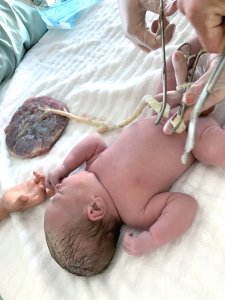4 Unbelievable facts about the placenta
and why it is beneficial to delay cord clamp at birth.
Why is the placenta valuable?
- Women’s bodies are amazing and the placenta is a huge part of that miracle growing inside of them. The placenta is an organ that nourishes the fetus through the umbilical cord. Most people give very little thought to the placenta, and only a few appreciate the unbelievable complexity and importance of this organ that is usually quickly discarded and forgotten after birth.
The placenta is the organ that grows in the uterus and attaches into the mother’s body to provide the fetus with oxygen, blood, and nutrients. Although we know a lot of fascinating facts about the placenta, scientists still have plenty of questions about it.
Have you ever seen a placenta?
Most people would say no.
Why? Because more often than not, after birth, the placenta is delivered, cut quickly and thrown away in the hospital, without the mother or father seeing it. Placentas are truly incredible though. They look similar to the tree of life. As the placenta leaves your body and gets detached from the baby, it is a beautiful symbol of new life.
4 unbelievable facts about the placenta you should know before giving birth.
1) The placenta is the ONLY ORGAN that a woman grows, and then it leaves her body.
It gives the baby oxygen, blood, and nutrients for 9 months. It transfers antibodies from mom to baby and can provide 3-6 months of immunity after baby is born.
2) The Placenta is a multifunctional organ
The placenta acts as baby’s lungs to supply oxygen, kidneys to filter out waste, and as gastrointestinal and immune systems by delivering nutrients and antibodies.
3) The blood from the Mother and Baby pass through the placenta, but they never mix.
When the baby develops it’s own blood and blood vessels, the mother’s blood and the blood of the developing baby come into close contact, but they never mix. Every minute, during pregnancy, one pint of blood is pumped to the uterus, exchanging oxygen and nutrients through the placenta. If their blood mixes, it could be dangerous for both of them. The placenta plays a very important role to make sure the mother’s blood passing through separate arteries in the placenta.
4) Women can consume their placenta after birth.
Anecdotal evidence shows that mothers who eat their placentas after birth reap numerous benefits. These benefits include more balanced hormones, increased energy and milk supply, a reduction in postpartum bleeding, and restoration of iron.
STOP Early Cord Clamping!
Often times at a birth, doctors will clamp the cord right away. Recently, you may have seen articles about “why it’s important to delay cord clamp”. The truth is, “delayed cord clamping “isn’t a new discovery or a “new trend”. Delayed cord clamping is what is norma and what has always been “normal”.
Unfortunately, normal cord clamping is new to many mothers because most parents don’t realize they have a choice due to the lack of research in the past has meant for many years where the standard care during delivery has been immediate cord clamping after birth.

My husband cutting my son’s umbilical cord at home.
“Wait for White” You can see in this picture above that the Umbilical Cord is white and no longer pulsing. This is my husband cutting the cord from my youngest son.
Benefits to stopping early cord clamping:
In full term infants, up to 30% of babies’ blood can be left behind in the placenta and cord. In preterm infants it’s an even higher percentage. The WHO (World Health Organization) now recommends waiting at least one minute after birth to clamp the cord or until it turns white.
It is most beneficial for the baby when you “Wait for white”. There is evidence to suggest that is beneficial to wait until all of the blood in the cord is transferred to the newborn’s body post-birth because when the baby is first born they are sharing their blood with the placenta. Waiting to clamp the cord allows to transfer a healthy blood volume to baby for the transition of life outside the womb and a full count of red blood cells, stem cells and immune cells.
Waiting can increase iron stores in your baby for up to 6 months old and sometimes up to age 4. Delayed Cord clamping or “normal” clamping, gives newborns higher levels of iron, lower risk of anemia, fewer transfusions and fewer incidence of hemorrhage.
Risks to cutting the cord early:
Consequently, any interference before the cord stops pushing can disturb the blood flowing to the baby. This can put newborns at risk for anemia, low iron levels, higher risk of needing a blood transfusion and higher incidences of hemorrhage.
How do I delay Cord Clamp?
Talk to your doctor, midwife or health care provider ahead of time during one of your prenatal appointments. Ask them how long they wait to cut the umbilicial cord. If they cut immediately or they aren’t willing to wait, I would start looking into a new provider. It is important to communicate all your wishes and wants before you go into labor so you and your birthing team are on the same page for your birth plan.
Tips for Successful Cord Clamping.
- Remember: “WAIT FOR WHITE”.
- Tell your wishes to your health care provide ahead of time
- If you have a doula let her know your preferences as well, so she can help remind your doctor or midwife after birth. Doulas are great advocates an helpful to have to assist you and your husband during birth!
Common Questions/FAQ
How long should I wait until I cut my baby’s cord.
- “Wait for white”. Wait until the cord stops pulsing and the cord turns white. This indicates the blood has transferred to the baby. Most hospital births will wait 1-3 minutes. Home births can wait longer.
- I waited about 30 minutes to clamp the cord after my home water birth. Mainly, because I was snuggling my new bundle of joy and didn’t want to be disturbed.
Will my doctor allow me to “Delay cord clamp”
- Yes. Most Health care providers will allow you to. Remember this isn’t something new. This is traditional cord clamping. Hospitals have recently gotten into a new routine of “early cord clamping” Discuss with your health care provider ahead of time what your umbilical cord clamping wishes are. If they won’t let you wait, you can always find another provider who will be more aligned with your wishes.
How does the cord get cut?
- The cord will be clamped near your baby’s belly button and farther down the cord. Then the cord will be cut between the two clamps. If you have your partner with you, your doctor or midwife may ask if they would like to cut the cord. You can request this, as well.
The Last Thing You Need to Know About Stopping “Early Cord Clamping”
There are none know risks for waiting to cut the cord and many benefits. An extra 30 seconds -3 minutes can greatly benefit your baby’s blood cells count and iron levels giving them a healthier start to their life outside your womb.
Tell us your story below:
- Did you early cord clamp or delay cord clamp? We would love to hear your story below!




This is so informative! Honestly I wish I would’ve read this before giving birth to my daughter. I didn’t know anything about my placenta other than it was almost impossible to come out. I really wanted to keep mine and put it into pill form but nobody in my family thought it was a good idea. I will definitely be rereading this when I have baby number 2 !
I delayed cord clamping with 3 of my 4 biological kids, and I don’t regret it. I would have done it with my 4th, but he needed medical attention at birth so it wasn’t a priority. I highly recommend delayed cord clamping. Thanks fo the great resource.
Wow, I have to deeply consider this! I’m due in 6 weeks and this is something I’m definitely going to bring up on my next appointment. Thank you for this info!
This is an amazing set of information..I really didn’t know much about it..Thanks for sharing!
I really love and appreciate this post. I have never heard of delayed cord clamping and its benefits. This is very informative and educating. Thank you.
We delayed with all 5, but only by a few minutes. We saw my placenta with a few births and took pictures to show the kids. Birth truly is amazing! Thanks for sharing about an important topic.